New Simplified Chemistry Class 10 ICSE Solutions – Mole Concept and Stoichiometry : Percentage Composition – Empirical & Molecular Formula Calculations Based on Chemical
ICSE SolutionsSelina ICSE SolutionsML Aggarwal Solutions
Viraf J Dalal Chemistry Class 10 Solutions and Answers
Simplified ChemistryEnglishMathsPhysicsChemistryBiology
Additional Problems
Q.1. Percentage Composition
Question 1.
Calculate the percentage by weight of :
(a) C in carbon dioxide
(b) Na in sodium carbonate
(c) Al in aluminium nitride.
[C = 12, O = 16, H = 1, Na = 23, Al = 27, N = 14]
Answer:
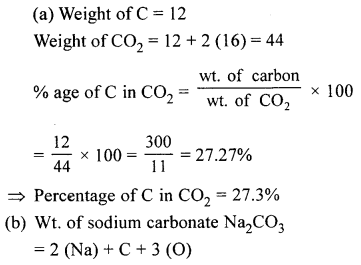
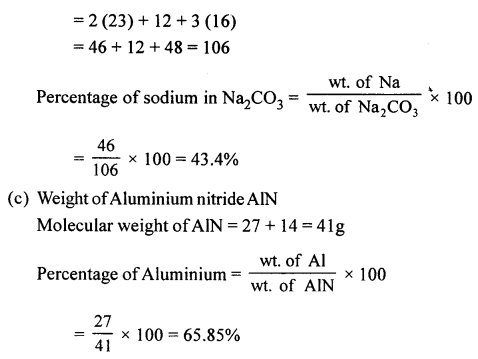
Question 2.
Calculate the percentage of iron in K3Fe(CN)6. [K = 39,Fe = 56, C = 12, N = 14]
Answer:
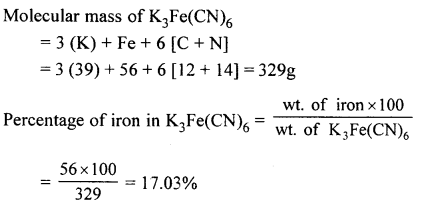
Question 3.
Calculate which of the following – calcium nitrate or ammonium sulphate has a higher % of nitrogen.[Ca = 40, S = 32, N = 14, O = 16]
Answer:

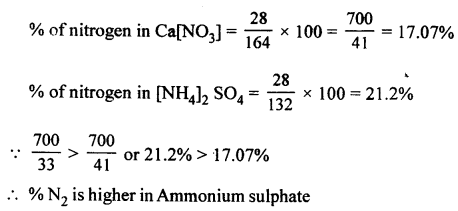
Question 4.
Calculate the percentage of pure aluminium in 10kg. of aluminium oxide [Al2O3] of 90% purity. [Al = 27, O = 16]
Answer:
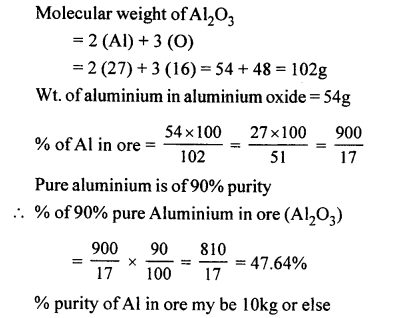
Question 5.
State which of the following are better fertilizers —
- Potassium phosphate [K3PO4] or potassium nitrate [KNO3]
- Urea [NH2CONH2] or ammonium phosphate [(NH4)3PO4]
[K = 39, P = 31, O = 16, N = 14, H = 1]
Answer:

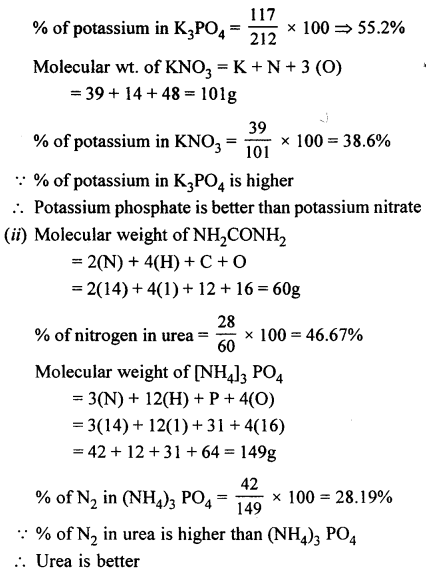
Question 6.
Calculate the percentage of carbon in a 55% pure sample of carbon carbonate. [Ca = 40, C = 12, O = 16]
Answer:
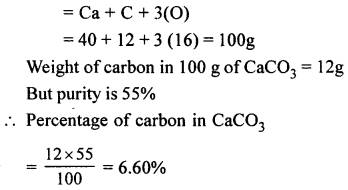
Question 7.
Calculate the percentage of water of crystallisation in hydrated copper sulphate [CuSO4.5H2O].
[Cu = 63.5, S = 32, O = 16, H = 1]
Answer:
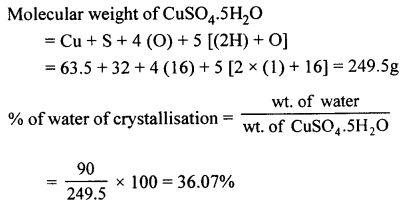
Question 8.
Hydrated calcium sulphate [CaSO4xH2O] contains 21% of water of crystallisation. Calculate the number of molecules of water of crystallisation Le. ‘X’ in the hydrated compound.
[Ca = 40, S = 32, O = 16, H = 1]
Answer:
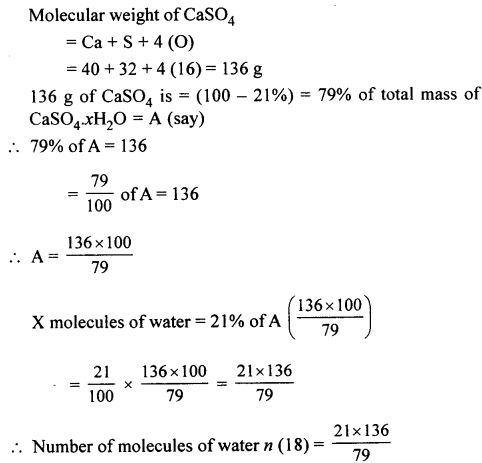

Q.2. Empirical And Molecular Formula
Question 1.
A compound gave the following data : C = 57.82%, O = 38.58% and the rest hydrogen. Its vapour density is 83. Find its empirical and molecular formula. [C = 12, O = 16, H = 1]
Answer:
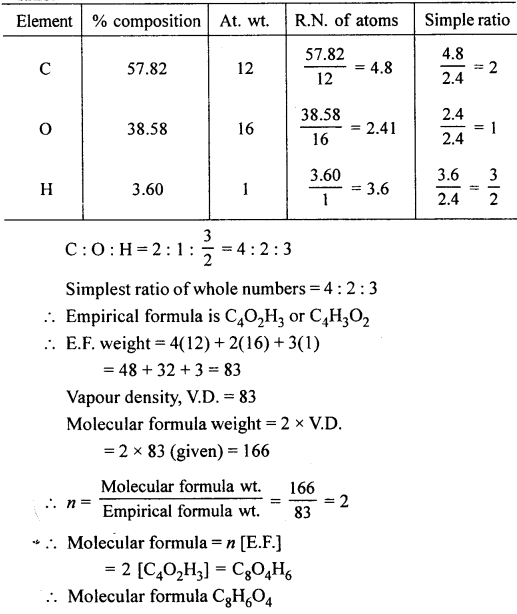
Question 2.
Four g of a metallic chloride contains 1.89 g of the metal ‘X’. Calculate the empirical formula of the metallic chloride. [At. wt. of ‘X’ = 64, Cl = 35.5]
Answer:
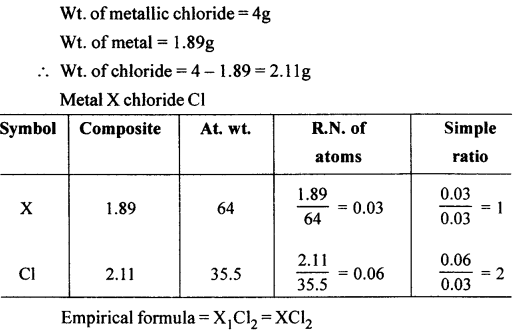
Question 3.
Calculate the molecular formula of a compound whose empirical formula is CH2O and vapour density is 30.
Answer:
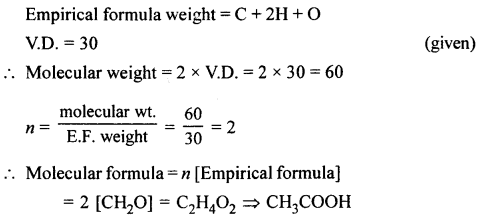
Question 4.
A compound has the following percentage composition. Al = 0.2675g.; P = 0.3505g.; O = 0.682g. If the molecular weight of the compound is 122 and its original weight on analysis gave the above results 1.30 g. Calculate the molecular formula of the compounds
[Al = 27, P = 31, O = 16]
Answer:
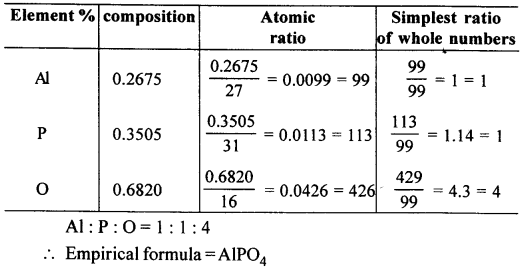
Question 5.
Two organic compounds ‘X’ and ‘Y’ containing carbon and hydrogen only have vapour densities 13 and 39 respectively. State the molecular formula of ‘X’ and ‘Y’ [C = 12, H = 1]
Answer:
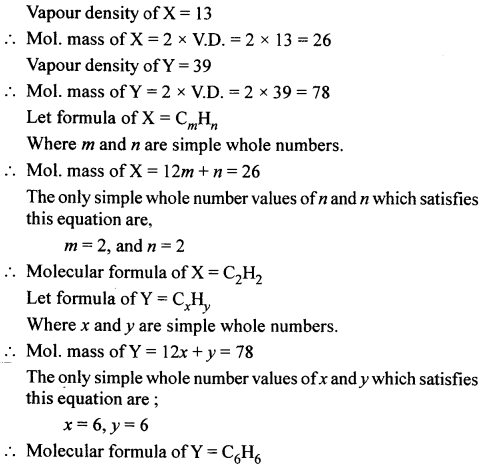
Question 6.
A compound has the following % composition. Zn = 22.65%; S = 11.15%; O = 61.32% and H = 4.88%. Its relative molecular mass is 287 g. Calculate its molecular formula assuming that all the hydrogen in the compound is present in combination with oxygen as water of crystallization.
[Zn = 65, S — 32, O = 16, H = 1]
Answer:
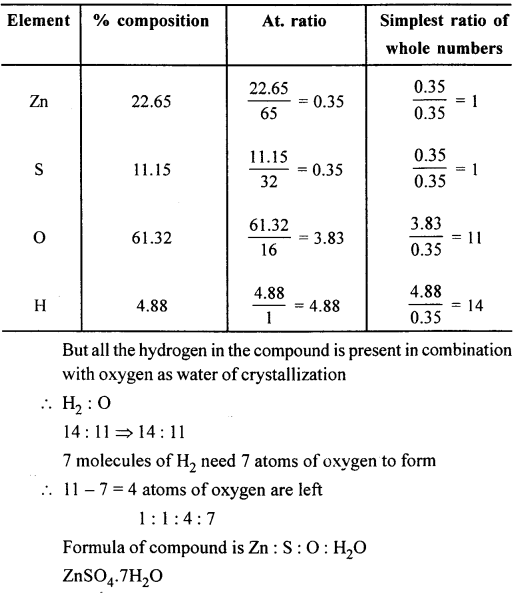
Question 7.
A hydrocarbon contains 82.8% of carbon. Find its molecular formula if its vapour density is 29 [H = 1, C = 12]
Answer:
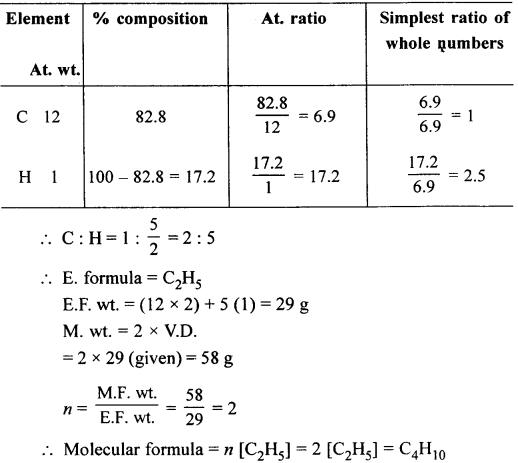
Question 8.
An organic compound on analysis gave H = 6.48% and O = 51.42%. Determine its empirical formula if the compound contains 12 atoms of carbon.
[C = 12, H = 1, O = 16]
Answer:
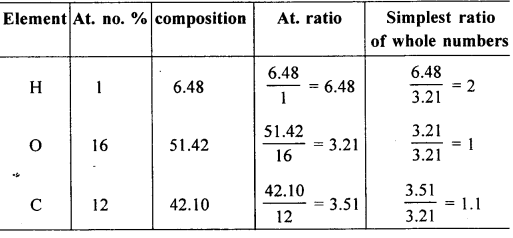
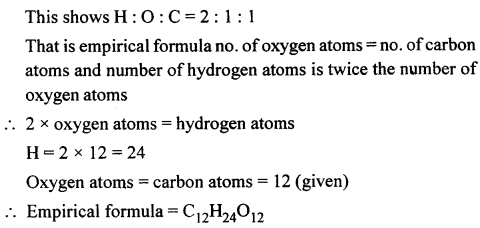
Question 9.
A hydrated salt contains Cu = 25.50%, S = 12.90%, O = 25.60% and the remaining % is water of crystallization. Calculate the empirical formula of the salt.
[Cu = 64, S = 32, O = 16, H = 1]
Answer:
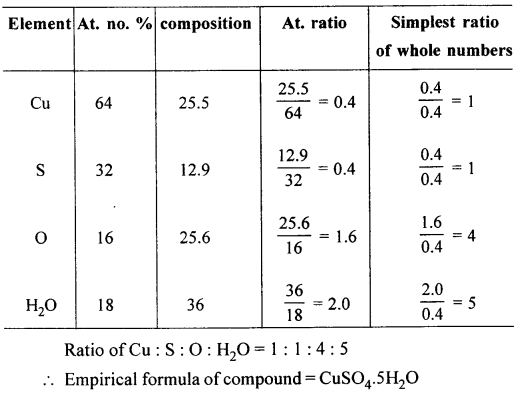
Question 10.
A gaseous hydrocarbon weights 0.70 g. and contains 0.60 g. of carbon. Find the molecular formula of the compound if its molecular weight is 70.
[C = 12, H = 1]
Answer:
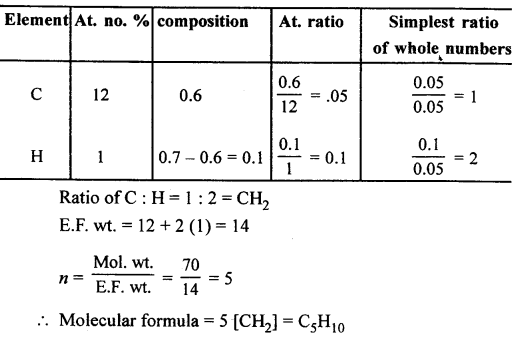
Question 11.
A salt has the following % composition Al = 10.50%, K = 15.1%, S = 24.8% and the remaining oxygen. Calculate the empirical formula of the salt.
[Al = 27, K = 39, S = 32, O = 16]
Answer:


Q.3. Chemical Equations
Question 1.
What mass of silver chloride will be obtained by adding an excess of hydrochloric acid to a solution of 0.34 g of silver nitrate.
[Cl = 35.5, Ag = 108, N = 14, O = 16, H = 1]
Answer:
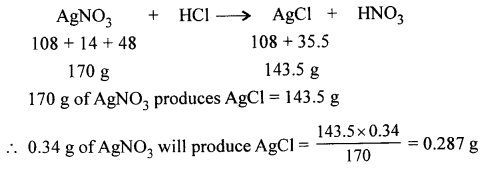
Question 2.
What volume of oxygen at s.t.p. will be obtained by the action of heat on 20 g
KClO3 [K = 39, Cl = 35.5, O = 16]
Answer:

Question 3.
From the equation : 3Cu + 8HNO3 → 3Cu(NO3)2 + 4H2O + 2NO. Calculate
- the mass of copper needed to react with 63 g of nitric acid
- the volume of nitric oxide collected at the same time. [Cu = 64, H = 1, O = 16, N = 14]
Answer:
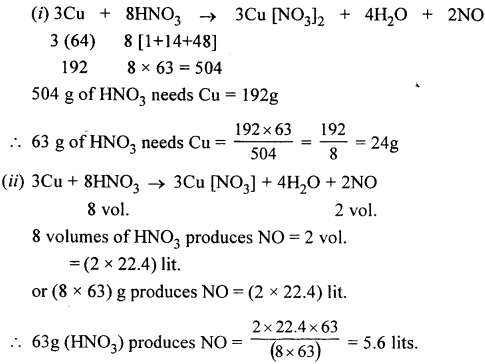
Question 4.
Zinc blende [ZnS] is roated in air. Calculate :
(a) The number of moles of sulphur dioxide liberated by 776 g of ZnS and
(b) The weight of ZnS required to produce 22.4 lits. of SO2 at s.t.p. [S = 32, O = 16, Zn = 65]
Answer:

Question 5.
Ammonia reacts with sulphuric acid to give the fertilizer ammonium sulphate. Calculate the volume of ammonia [at s.t.p.] used to form 59 g of ammonium sulphate.
[N = 14, H = 1, S = 32, O = 16]
Answer:
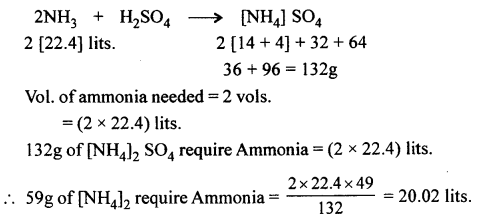
Question 6.
Heat on lead nitrate gives yellow lead [II] oxide, nitrogen dioxide and oxygen. Calculate the total volume of NO2 and O2 produced on heating 8.5 of lead nitrate.
[Pb = 207, N = 14, O = 16]
Answer:
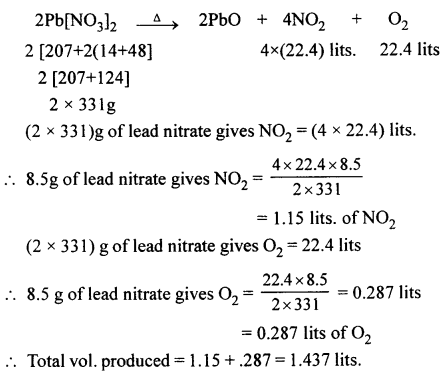
Question 7.
Calculate the amount of KClO3 which on thermal decomposition gives ‘X’ vol. of O2, which is the volume required for combustion of 24 g. of carbon.
![]()
[K = 39, Cl = 35.5, O = 16, C = 12].
Answer:
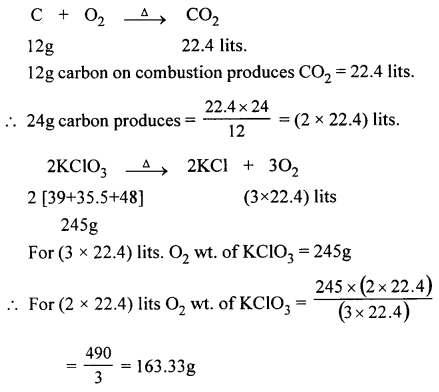
Question 8.
Calculate the weight of ammonia gas.
(a) Required for reacting with sulphuric acid to give 78g. of fertilizer ammonium sulphate.
(b) Obtained when 32.6g. of ammonium chloride reacts with calcium hydroxide during the laboratory preparation of ammonia.
[2NH4Cl + Ca(OH)2 → CaCl2 + 2H2O + 2NH3] [N = 14, H = 1, O = 16, S = 32, Cl = 35.5].
Answer:
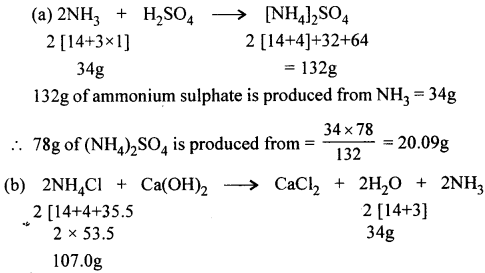

Question 9.
Sodium carbonate reacts with dil. H2SO4 to give the respective salt, water and carbon dioxide. Calculate the mass of pure salt formed when 300 g. of Na2CO3 of 80% purity reacts with dil. H2SO4.
[Na = 23, C = 12, O = 16, H = 1, S = 32].
Answer:
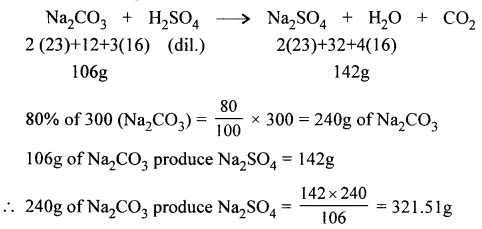
Question 10.
Sulphur burns in oxygen to give sulphur dioxide. If 16 g. of sulphur burns in ‘x’ cc. of oxygen, calculate the amount of potassium nitrate which must be heated to produce V cc. of oxygen. [S = 32, K = 39, N = 14, O = 16].
Answer:
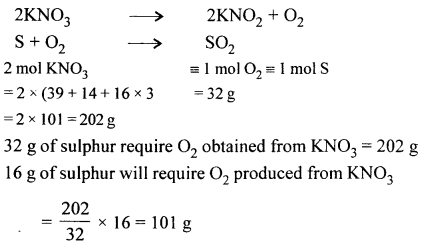
Question 11.
Sample of impure magnesium is reacted with dilute sulphuric acid to give the respective salt and hydrogen. If 1 g. of the impure sample gave 298.6 cc. of hydrogen at s.t.p. Calculate the % purity of the sample. [Mg = 24, H = 1].
Answer:
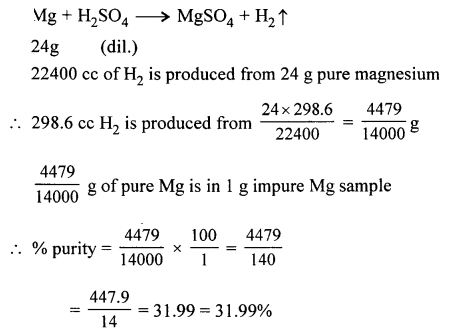
Questions
A. Lussac’S Law – Problems based on them
2006
Question 1.
560 ml. of carbon monoxide is mixed with 500 ml of oxygen and ignited. The chemical equation for the reaction is as follows : 2CO + O2 → 2CO2. Calculate the volume of oxygen used and carbon dioxide formed in the above reaction.
Answer:
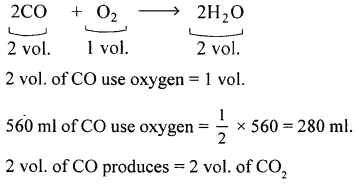
![]()
2009
Question 1.
200 cm3 of acetylene is formed from a certain mass of calcium carbide, find the volume of oxygen required and carbon dioxide formed during the complete combustion. The combustion reaction can be represented as below.
2C2H2(g) + 5O2 (g) → 4CO2 (g) + 2H2O (g)
Answer:

2010
Question 1.
10 litre of this mixture is burnt, And the total volume of carbon dioxide gas added to the atmosphere. Combustion reaction can be represented as :
![]()
![]()
Answer:
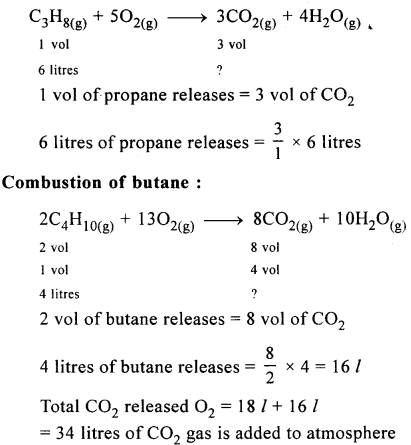
2012
Question 1.
67.2 litres of H2 combines with 44.8 litres of N2 to form NH3 :
N2(g) + 3H2(g) → 2NH3(g). Calculate the vol. of NH3 produced. What is the substance, if any, that remains in the resultant mixture ?
Answer:

2013
Question 1.
What volume of oxygen is required to burn completely 90 dm3 of butane under similar conditions of temperature and pressure?
2C4H10 + 13O2 → 8CO2 + 10H2O
Answer:
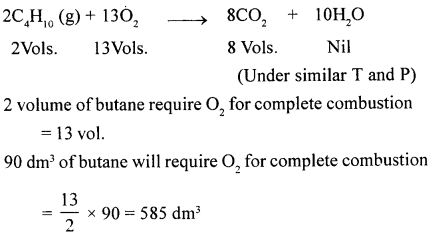
2014
Question 1.
What volume of ethyne gas at s.t.p. is required to produce 8.4 dm3 of carbon dioxide at s.t.p.?
2C2H2 + 5O2 → 4CO2 + 2H2O [H = 1, C = 12, O = 16]
Answer:
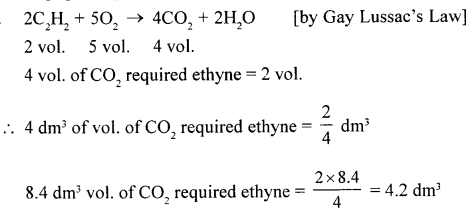
2015
Question 1.
If 6 litres of hydrogen and 4 litres of chlorine are mixed and exploded and if water is added to the gases formed, find the volume of the residual gas.
Answer:


2016
Question 1.
The equations 4NH3 + 5O2 → 4NO + 6H2O, represents the catalytic oxidation of ammonia. If 100 cm3 of ammonia is used calculate the volume of oxygen required to oxidise the ammonia completely.
Answer:

2017
Question 1.
Propane burns in air according to the following equation :
C3H8 + 5O2 → 3CO2 + 4H2O. What volume of propane is consumed on using 1000 cm3 of air, considering only 20% of air contains oxygen.
Answer:


B. Mole Concept – Avogadro’S Number – Problems based on them
2004
Question 1.
A flask contains 3.2 g of SO2. Calculate :
- The moles of SO2 and the no. of molecules of SO2 present in the flask.
- The volume occupied by 3.2 g. of SO2 at s.t.p. (S = 32, O = 16)
Answer:
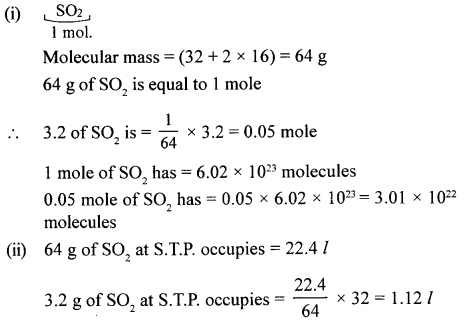
Question 2.
2KMnO4 → K2MnO4 + MnO2 + O2 Given that the molecular mass KMn04 is 158, what volume of oxygen (measured at room temperature) would be obtained by the complete decomposition of 15.8 g. of potassium permanganate. (Molar volume at room temperature is 24 litres.)
Answer:


2005
1. The volumes of gases A, B, C and D are in the ratio, 1 : 2 : 2 : 4 under the same conditions of temp, and press.
(i) Which sample contains the maximum number of molecules. If the temp, and pressure of gas A are kept constant, then what will happen to the volume of A when the no. of molecules is doubled.
Answer:
The sample D and volume of A will get Doubled.
(ii) If this ratio of gas vols. refers to reactants and products of reaction – gas law observed is ….
Answer:
Gay Lussac’s law of combining volumes.
(iii) If the volume of ‘A’ is 5.6 dm3 at s.t.p., calculate the no. of molecules in the actual vol. of ‘D’ at s.t.p. (Avog no. is 6 × 1023). Using your answer, state the mass of ‘D’ if the gas is “N2O” (N = 14, O = 16). [6 x 1023, 44g.]
Answer:
Vol. of D will be 4 × 5.6 = 22.4 lit. and 22.4 lit. of D contain molecules = 6 × 1023 (AV. number)
Mass of N2 O (i.e. D) = (14 × 2 + 16 × 1) = 44g
2006
Question 1.
Calculate the no. of moles and the no. of molecules present in 1.4 g of ethylene gas (C2H4). What is the vol. occupied by the same amount of C2H4. State the vapour density of C2H4.
(Avog. No. = 6 × 1023 ; C = 12, H = 1]
(0.05 moles ; 3 × 1022 molecules ; 1.12 lit. ; 14)
Answer:


2008
1. The equation for the burning of octane is : 2C8H18 + 25O2 → 16CO2 + 18H2O
(i) How many moles of carbon dioxide are produced when one mole of octane burns ?
Answer:
2 moles of octane produce 16 moles of C02
1 mole of octane will produce 16/2 moles of C02 = 8 moles of carbon dioxide.
(ii) What volume, at s.t.p., is occupied by the number of moles determined in (1) (i) ?
Answer:
1 moles occupy a volume of 22.4 litres.
8 mole will occupy a volume of = 22.4 × 8 = 179.2 litres
(iii) If the relative molecular mass of carbon dioxide is 44, what is the mass of carbon dioxide produced by burning two moles of octane ?
Answer:
From equation, we know that 2moles of octane produces 16 moles of CO2.
Mass of CO2 produced = 16 × 44 = 704
2009
Question 1.
Define the term – Mole. A gas cylinder contains 24 × 1024 molecules of nitrogen gas. If Avogadro’s number is 6 × 1023 and the relative atomic mass of nitrogen is 14, calculate :
- Mass of nitrogen gas in the cylinder.
- Volume of nitrogen at STP in dm3
Answer:

Question 2.
Gas ‘X’ occupies a volume of 100 cm3 at S.T.P and weighs 0.5 g. find its relative molecular mass.
Answer:

2010
Question 1.
Dilute hydrochloric acid (HCl) is reacted with 4.5 moles of calcium carbonate. Give the equation for the said reaction. Calculate :
- The mass of 4.5 moles of CaCO3.
- The volume of CO2 liberated at stp.
- The mass of CaCl2 formed ?
- The number of moles of the acid HCl used in the reaction (relative molecular mass of CaCO3 is 100 and of CaCl2 is 111].
Answer:
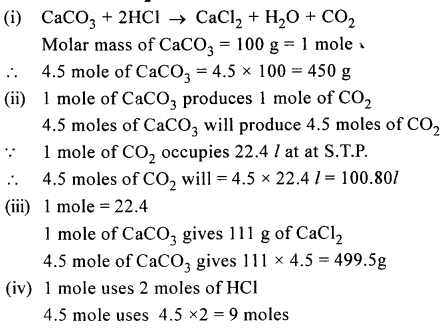
2011
Question 1.
Calculate the mass of :
- 1022 atoms of sulphur.
- 0.1 mole of carbon dioxide.
[S = 32, C = 12 and O = 16 and Avogadro’s Number 6 × 1023]
Answer:

Question 2.
Calculate the volume of 320 g of SO2 at stp. [S = 32 and O = 16]
Answer:


2012
Question 1.
The mass of 5.6 dm3 of a certain gas at STP is 12.0 g. Calculate the relative molecular mass of the gas.
Answer:

2013
Question 1.
The vapour density of a gas is 8. What would be the volume occupied by 24.0 g of the gas at STP ?
Answer:
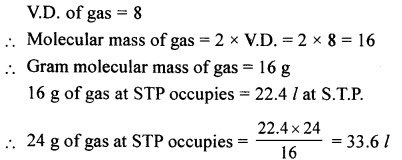
Question 2.
Calculate the volume occupied by 0.01 mole of CO2 at STP.
Answer:

2014
Question 1.
State Avogadro’s Law. A cylinder contains 68g of ammonia gas at s.t.p.
- What is the volume occupied by this gas?
- How many moles and how many molecules ammonia are present in the cylinder? [N = 14, H = 1]
Answer:

2015
Question 1.
From A, B, C, D, which weighs the least —
A : 2 g. atoms of Nitrogen
B : 1 mole of Silver
C : 22.4 litres of oxygen gas at 1 atmospheric pressure and 273K
D : 6.02 × 1o23 atoms of carbon.
[Ag = 108, N=14, 0=16, C=12]
Answer:
D : 6.02 × 1023 atoms of carbon.
Question 2.
Calculate the mass of Calcium that will contain the same number of atoms as are present in 3.2 gm of sulphur. [S = 32, Ca = 40]
Answer:
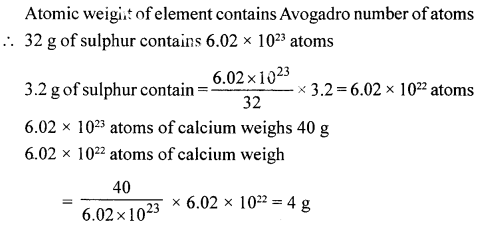
2016
Question 1.
Select the correct answer from A, B, C and D : The ratio between the number of molecules in 2g of hydrogen and 32g of oxygen is: k
(A) 1 : 2
(B) 1 : 0.01
(C) 1:1
(D) 0.01 : 1
[H = 1, O = 16]
Answer:
(C) 1 : 1
Question 2.
A gas of mass 32 gms has a volume of 20 litres at S.T.P. Calculate the gram mol. weight of the gas.
Answer:

Question 3.
A gas cylinder contains 12 x 1024 molecules of oxygen gas. Calculate :
- the mass of 02 present in the cylinder.
- the volume of O2 at S.T.P. present in the cylinder.[0 = 16] Avog. no. is 6 × 1023 [640g. ; 448 l]
Answer:
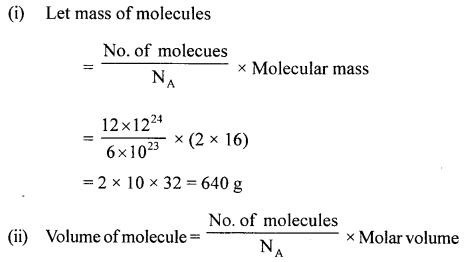

2017
Question 1.
Calculate the number of gram atoms in 4.6 grams of sodium [Na = 23]
Answer:

Question 2.
The mass of 11.2 litres of a certain gas at s.t.p. is 24 g. Find the gram molecular mass of the gas.
Answer:

C. Mole Concept – Avogadro’S Law – problmes based on them
2001
Question 1.
The gases chlorine, nitrogen, ammonia and sulphur dioxide are collected under the same conditions of temperature and pressure. If 20 litres of nitrogen contain ‘X’ no. of molecules state the no. of molecules in 10 litres of chlorine, 20 litres of ammonia and 5 litres of sulphur dioxide, (x/2, x, x/4)

Answer:
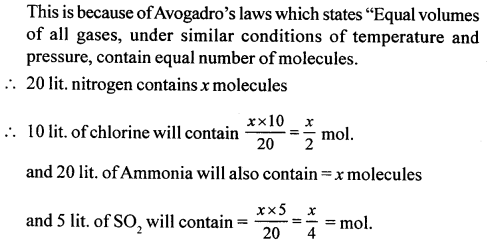
2002
Question 1.
Samples of gases O2, N2, CO and CO2 under the same conditions of temperature and pressure contain the same number of molecules represented by X. The molecules of oxygen occupy V litres and have a mass of 8 g. Under the same conditions of temperature and pressure, what is the volume occupied by :
- X molecules of N2.
- 3X molecules of CO.
- What is the mass of CO2 in grams.
- In answering the above questions, whose law has been used.
(C = 12, N = 14, O = 16)
Answer:

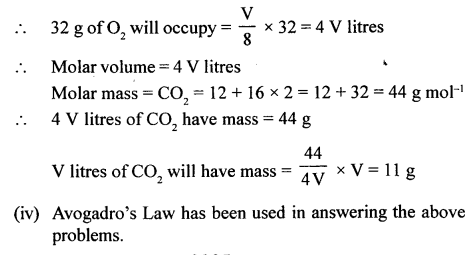
2005
Question 1.
Define the term atomic weight :
Answer:
Atomic weight : is the number of times one atom of an element is heavier than 1/2 the mass of an atom of carbon (C12)
2008
Question 1.
The gas law which relates the volume of a gas to the number of molecules of the gas is :
A Avogadro’s Law
B Gay-Lussac’s Law
C Boyle’s Law
D Charle’s Law
Answer:
A Avogadro’s Law
2009
Question 1.
Correct the following – Equal masses of all gases under identical conditions contain the same number of molecules.
Answer:
Equal volumes of all gases under identical conditions contain the same number of molecules.
2013
Question 1.
A vessel contains X number of molecules of hydrogen gas at a certain temperature & pressure. Under the same conditions of temperature & pressure, how many molecules of nitrogen gas would be present in the same vessel.
Answer:
According to Avogadro’s law, equal volume of all gases under similar conditions of temperature and pressure contain equal number of molecules.
Hence, number of molecules of N2 = Number of molecules of H2 = X
2017
Question 1.
A gas cylinder can hold 1 kg. of H2 at room temp. & press.:
- Find the number of moles of hydrogen present
- What weight of CO2 can the cylinder hold under similar conditions to temp. & press
- If the number of molecules of hydrogen in the cylinder is X, calculate the number of CO2 molecules in the cylinder under the same conditions of temp. & press
- State the law that helped you to arrive at the above result.
Answer:
- 2 g of hydrogen gas = 1 mole.
∴ 1000 g of hydrogen gas 1000/2 = 500 moles. - 1 mole of carbon dioxide = 44 g
∴ 500 moles of carbon dioxide = 44 x 500 = 22000 g = 22 kg Weight of carbon dioxide in cylinder = 22 kg - Equal volumes of all gases under similar conditions of temperature and pressure contain equal number of molecules.
∴ Molecules in the cylinder of carbon dioxide = X. - Avogadro’s law.
D. Vapour Density & Molecular Weight – Problems based on them
1996
Question 1.
Find the relative molecular mass of a gas, 0.546 g of which occupies 360 cm3 at 87°C and 380 mm Hg pressure. (1 litre of hydrogen at s.t.p. weighs 0.09 g)
Answer:

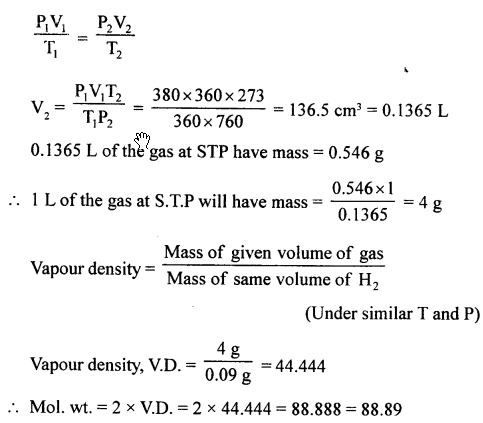
2001
Question 1.
Mention the term defined by the following : The mass of a given volume of gas compared to the mass of an equal volume of hydrogen.
Answer:
Vapour Density.
2004
Question 1.
Some potassium permanganate was heated in a test tube. After collecting one litre of oxygen at room temperature, it was found that the test tube had undergone a loss in a mass of 1.32 g. If one litre of hydrogen under the same conditions of temperature and pressure has a mass of 0.0825 g. Calculate the relative molecular mass of oxygen.

Answer:

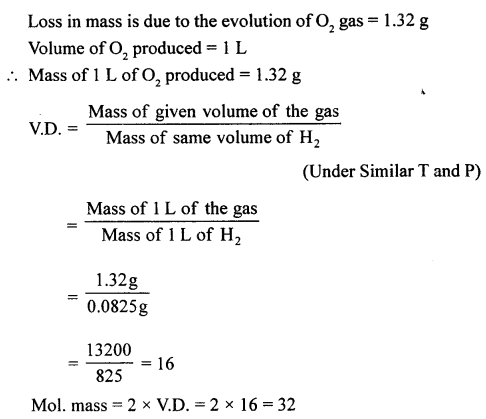
2009
Question 1.
A gas cylinder of capacity of 20 dm3 is filled with gas X the mass of which is 10 g. When the same cylinder is filled with hydrogen gas at the same temperature and pressure the mass of the hydrogen is 2g, hence the relative molecular mass of the gas is :
(A) 5
(B) 10
(C) 15
(D) 20
Answer:
(B) 10
2012
Question 1.
The vapour density of carbon dioxide [C = 12, O = 16] is
(A) 32
(B) 16
(C) 44
(D) 22
Answer:
(D) 22
2014
Question 1.
Give one word or phrase for : The ratio of the mass of a certain volume of gas to the mass of an equal volume of hydrogen under the same conditions of temperature and pressure.
Answer:
Vapour density.
E. Percentage Composition – Problems based on them
1996
Question 1.
Find the total percentage of oxygen in magnesium nitrate crystals : Mg(NO3)2. 6H2O
(H = 1, N = 14, O = 16, Mg = 24)
Answer:
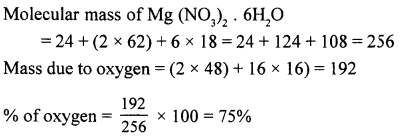
1997
Question 1.
What is the mass of nitrogen in 1000 kg of urea [CO(NH2)2].[C = 12] (Answer to the nearest kg.)
Answer:

1998
Question 1.
Calculate the % of boron (B) in borax Na2 B4 O7. 10H2O. (H = 1, B = 11, O = 16, Na = 23)
Answer:

1999
Question 1.
If a crop of wheat removes 20 kg of nitrogen per hectare of soil, what mass in kg. of the fertilizer calcium nitrate would be required to replace the nitrogen in a 10 hectare field. (N = 14 ; O = 16 ; Ca = 40)
Answer:

2001
Question 1.
Calculate the percentage of phosphorus in the fertilizer superphosphate Ca(H2PO4)2. (correct to 1dp) (H = 1 ; O = 16 ; P = 31 ; Ca = 40)
Answer:

2002
Question 1.
Calculate the percentage of platinum in ammonium chloroplatinate (NH4)2 PtCl6
(Give your answer correct to the nearest whole number). (N = 14, H = 1, Cl = 35.5, Pt = 195)
Answer:
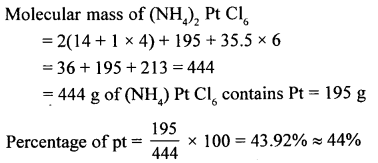
2005
Question 1.
Calculate the percentage of nitrogen in aluminium nitride. (Al = 27, N = 14)
Answer:

2006
Question 1.
Calculate the percentage of sodium in sodium aluminium fluoride (Na3AlF6) correct to the nearest whole number. (F = 19 ; Na = 23 ; A1 = 27)
Answer:
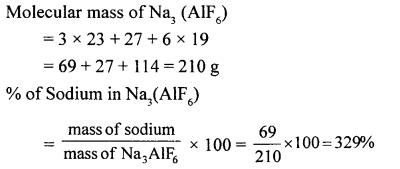
2007
Question 1.
Determine the percentage of oxygen in ammonium nitrate (O = 16)
Answer:

2010
Question 1.
If the relative molecular mass of ammonium nitrate is 80, calculate the percentage of nitrogen and oxygen in ammonium nitrate. (N = 14, H = 1, O = 16).
Answer:
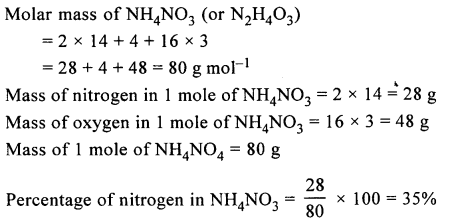
2012
Question 1.
Find the total percentage of Magnesium in magnesium nitrate crystals, Mg(NO3)2.6H2O/ [Mg = 24; N = 14; O = 16 and H = 1]
Answer:

2017
Question 1.
Calculate the percentage of water of crystallization in CUSO4.5H2O. [H = 1, O = 16, S = 32, Cu = 64]
Answer:

F. Empirical Formula And Molecular Formula – Problems based on then
2000
Question 1.
Determine the empirical formula of the compound whose composition by mass is : 42% nitrogen 48% oxygen and 9% hydrogen.
(H = 1 ; N = 14 ; O 16).
Answer:

2001
Question 1.
A metal M forms a voltaic chloride containing 65.5% chlorine. If the density of the chloride relative to hydrogen (i.e. V.D.) is 162.5, find the molecular formula of the chloride. (M = 56, Cl = 35.5)
Answer:


2002
Question 1.
The percentage composition of sodium phosphate as determined by analysis is 42.1% sodium, 18.9% phosphorus and 39% oxygen. Find the empirical formula of the compound (work to two decimal places). (Na = 23, P = 31, O = 16)
Answer:
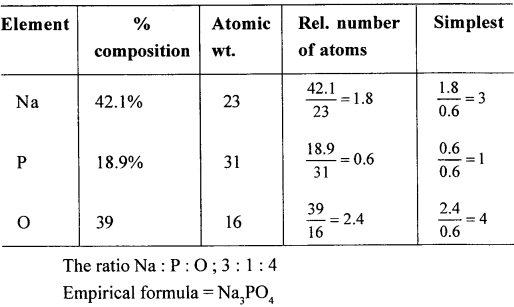
2004
Question 1.
An experiment showed that in a lead chloride solution, 6.21 g of lead combined with 4.26 g. of chlorine. What is the empirical formula of this chloride. (Pb = 207 ; Cl = 35.5)
Answer:
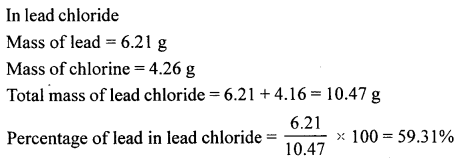
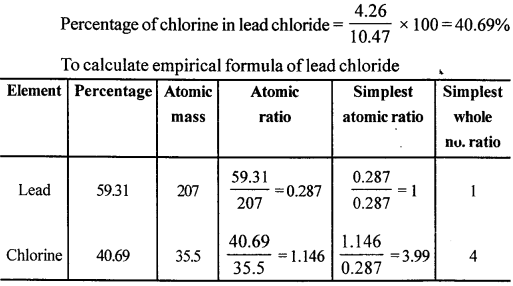
2006
Question 1.
Determine the empirical formula of a compound containing 47.9% potassium, 5.5% beryllium and 46.6% fluorine by mass.
(At. weight of Be = 9 ; F = 19 ; K = 39) Work to one decimal place.
Answer:
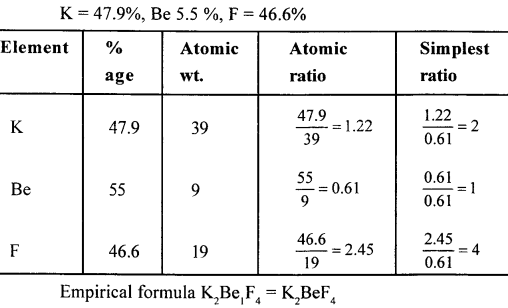
2007
Question 1.
A compound X consists of 4.8% carbon and 95.2% bromine by mass
- Determine the empirical formula of this compound working correct to one decimal place
- If the vapour density of the compound is 252, what is the molecular formula of the compound. (C = 12 ; Br = 80) (CBr3, C2Br6).
Answer:
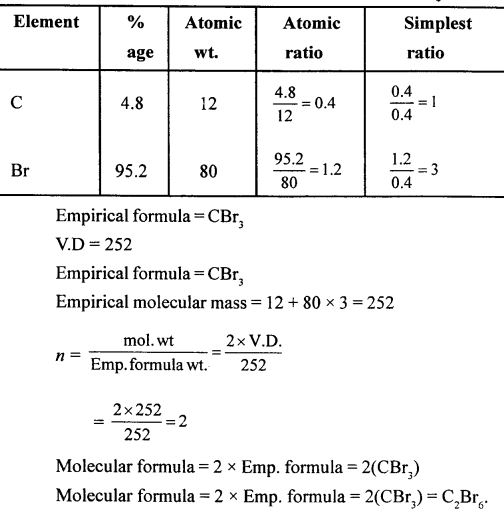
2008
Question 1.
What is the empirical formula of octane (C8H18) ?
Answer:
M.F. of octane = C8H18 = (c4H9)2
∴ E.F. of octane = C4H9
Question 2.
A compound has the following percentage composition by mass, Carbon 14.4%, hydrogen 1.2% and chlorine 84.5%. Determine the empirical formula of this compound. Work correct to 1 decimal place. The relative molecular mass of this compound is 168, so what is its molecular formula?
(H = 1 ; C = 12 ; Cl = 35.5)
Answer:
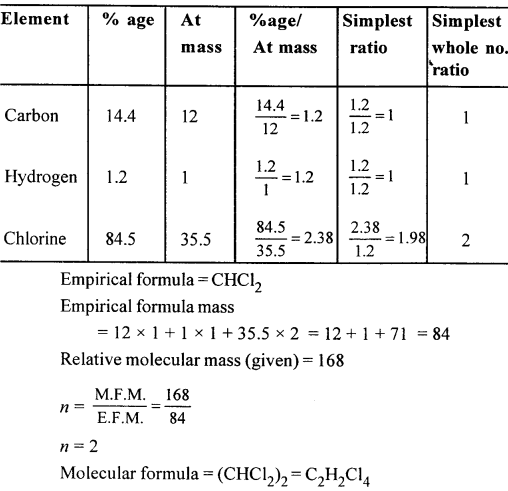
2009
Question 1.
A gaseous compound of nitrogen and hydrogen contains 12.5% hydrogen by mass. Find the molecular formula of the compound if its relative molecular mass is 37.
[N =14, H = 1].
Answer:

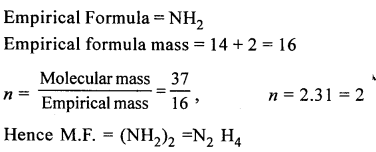
2011
Question 1.
An organic compound with vapour density 94. It contains C = 12.67%, H = 2.13%, and Br = 85.11%. Find the molecular formula of the organic compound.
[C = 12, H = 1, Br = 80]
Answer:

2014
Question 1.
A compound having empirical formula X2Y is made of two elements X and Y. Find its molecular formula. If the atomic weight of X is 10 and that of Y is 5 and the compound has a vapour density 25.
Answer:
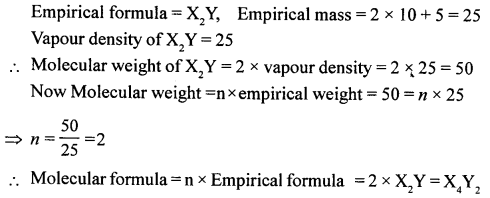
2015
Question 1.
If the empirical formula of a compound is CH and it has a vapour density of 13, find the molecular formula of the compound. [C = 12, H = 1]
Answer:
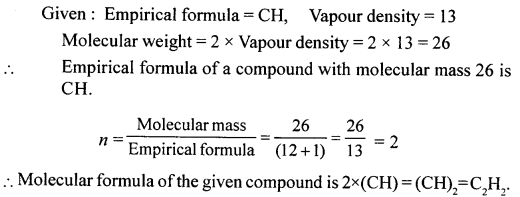
2016
Question 1.
A gaseous hydrocarbon contains 82.76% of carbon. Given that its vapours density is 29, find its molecular formula. [C=12,H=1]
Answer:
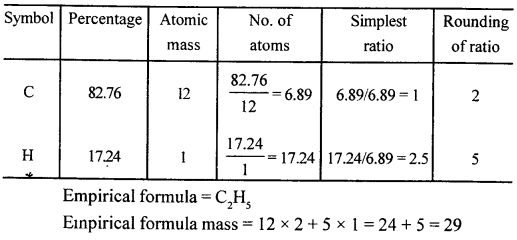

2017
Question 1.
A compound of X and Y has the empirical formula XY2. Its vapou density is equal to its empirical formula weight. Determine its Molecular formla.
Answer:

G Chemical Equations – Problems based on them
2000
Question 1.
Washing soda has the formula Na2CO3.10H2O. What mass of anhydrous sodium carbonate is left when all the water of crystallization is expelled by heating 57.2 g of washing soda.
Answer:
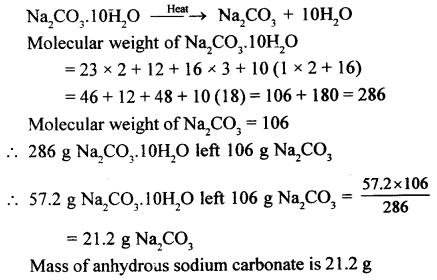
Question 2.
Na2SO4 + Pb(N03)2 → PbSO4 + 2NaNO3 When excess » lead nitrate solution was added to a solution of sodium sulphate, 15.15 g of lead sulphate were precipitated. What mass of sodium sulphate was present in the original solution. (H = 1 ; C = 12 ; O = 16 ; Na = 23; S = 32 ; Pb = 207)
Answer:

2001
Question 1.
From the equation : (NH4)2 Cr2O7 → Cr2O3 + 4H2O + N2 Calculate :
- the vol. of nitrogen at STP, evolved when 63g. of ammonium dichromate is heated. (5.6 lits.)
- the mass of Cr2O3 formed at the same time. (N = 14, H = 1, Cr = 52, O = 16) (38 g.)
Answer:
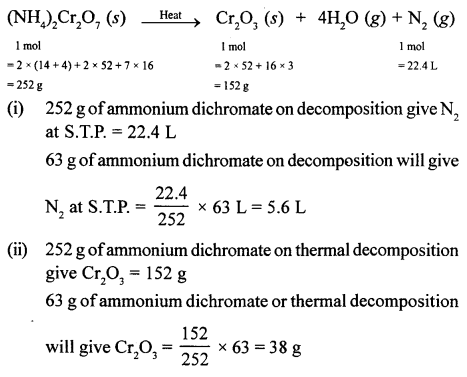
2003
Question 1.
10g. of a mixture of NaCI and anhydrous Na2SO4 is dissolved in water. An excess of BaCl2 soln. is added and 6.99 g. of BaSO is precipitated according to the equation :
Na2SO4 + BaCl2 → BaSO4 ↓+ 2NaCl. Calculate the percentage of sodium sulphate in the original mixture.
(O = 16 ; Na = 23 ; S = 32; Ba = 137)
Answer:
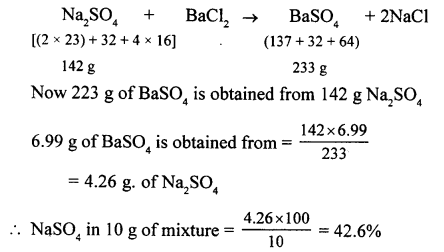
2004
Question 1.
The reaction of potassium permanganate with acidified iron (II) sulphate is given below :
2KMnO4 + 10FeSO4 + 8H2SO4 → K2SO4 + 2MnSO4 + 5 Fe2(SO4)3 + 8H2O.
If 15.8 g. of potassium permanganate was used in the reaction, calculate the mass of iron (II) sulphate used in the above reaction.
(K = 39, Mn = 55, Fe = 56, S = 32, O = 16)
Answer:


2005
Question 1.
The equation given below relate to the manufacture of sodium carbonate (Mol), wt. of Na2CO3 = 106
- NaCl + NH3 + CO2 + H2O → NaHCO3 + NH4Cl
- 2NaHCO3 → Na2CO3 + H2O + CO2
Questions (a) and (b) are based on the production of 21.2 g. of sodium carbonate.
(a) What mass of sodium hydrogen carbonate must be heated to give 21.2 g. of sodium carbonate (Molecular weight of NaHCO3 = 84).
(b) To produce the mass of sodium hydrogen carbonate calculated in (a), what volume of carbon dioxide, measured at s.t.p., would be required.
Answer:
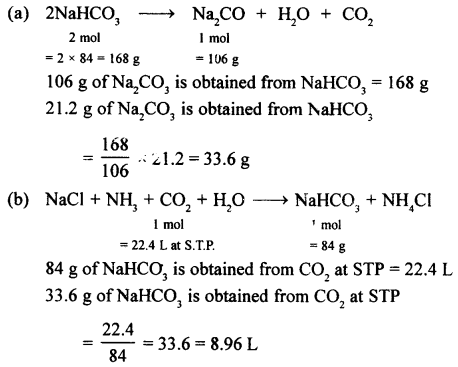
2006
Question 1.
The relative molecular mass (mol. wt.) of copper oxide is 80. What vol. of HN3 (measured at s.t.p.) is required to completely reduce 120 g of cuO.
(3CuO + 2NH3 → 3Cu + 3H2O + N2].
Answer:
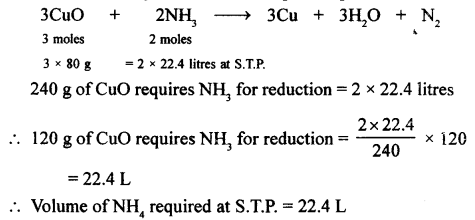
2007
Question 1.
A sample of ammonium nitrate when heated yields 8.96 litres of steam (measured at stp.)
NH4 NO3 → N2O + 2H2O
- What volume of dinitrogen oxide is produced at the same time as 8.96 litres of steam.
- What mass of ammonium nitrate should be heated to produce 8.96 litres of steam (Relative molecular mass of NH4NO3 is 80)
Answer:

2008
Question 1.
From the equation :
C + 2H2SO4 → CO2 + 2H2O + 2SO2
Calculate :
- The mass of carbon oxidised by 49 g of sulphuric acid (C = 12 ; relative molecular mass of sulphuric acid = 98).
- The volume of SO2 measured at s.t.p., liberated at the same time.
Answer:
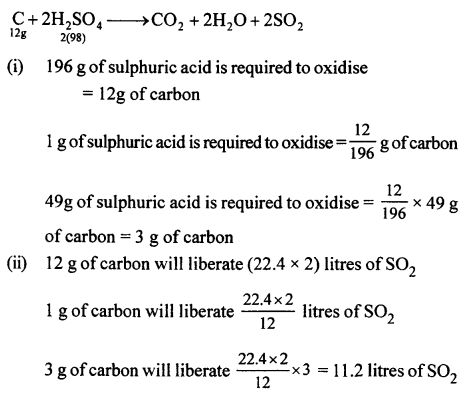
2009
Question 1.
Commercial NaOH weighing 30 g. has some NaCl in it. The mixture on dissolving in water and treatment with excess AgNO3 soln. formed a precipitate weighing 14.3 g. What is the percentage of NaCl in the commercial sample of NaOH.
NaCl + AgNO3 → AgCl + NaNO3
[Relative molecular mass of NaCl = 58 ; AgCl = 143]
Answer:
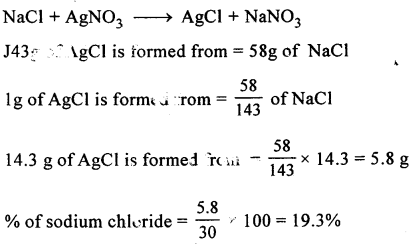
2011
Question 1.
Calculate the volume of oxygen required for the complete combustion of 8.8g of propane (C3 H8). (C = 12, O = 16, H = 1, Molar Volume = 22.4 dm3 at stp)
Answer:

2013
Question 1.

Answer:

2015
Question 1.
From the equation :
![]()
Calculate:
- the quantity in moles of (NH4)2Cr2O7 if 63gm oft[NH4)2Cr2O7 is heated.
- the quantity in moles of nitrogen formed.
- the volume in litres or dm3 of N2 evolved at s.t.p.
- the mass in grams of Cr2O3 formed at the same time. [H=l, Cr= 52, N=14]
Answer:

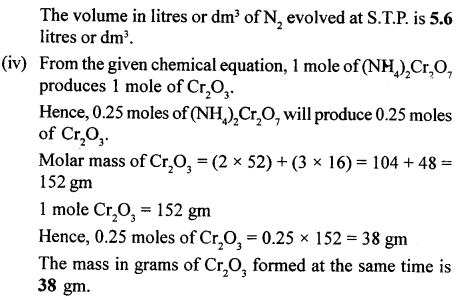
2016
Question 1.
How much calcium oxide is formed when 82g. of calcium nitrate is heated. Also find the volume of nitrogen dioxide evolved :
2Ca(NO3)2 → 2CaO + 4NO2 + O2 (Ca = 40, N = 14, O = 16)
Answer:
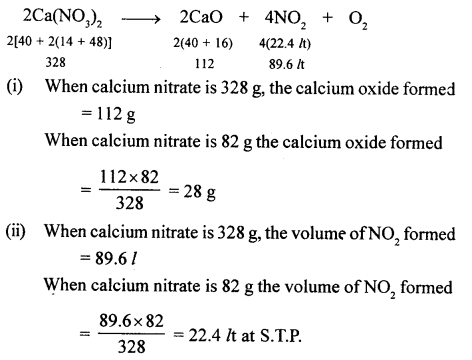
For More Resources